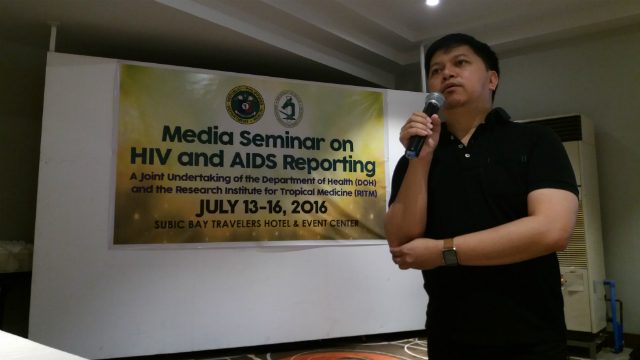SUMMARY
This is AI generated summarization, which may have errors. For context, always refer to the full article.

SUBIC BAY FREEPORT, Philippines – The government cannot solve the country’s growing human immunodeficiency virus/acute immunodeficiency syndrome (HIV/AIDS) epidemic alone and civil society has to fill the gaps in curbing the pandemic.
This was the key message of civil society groups during the second day of a media seminar on HIV/AIDS reporting on Friday, July 15, where they presented efforts that target key affected populations.
“This is not new. We’ve seen worldwide how HIV has caused communities to come together, collaborate, and cooperate. The government is not doing enough. The communities need to step up but the government has to lead the effort,” Chris Lagman, director of Learning and Development of LoveYourself Inc, said.
According to the latest report released by the Department of Health (DOH), around 25 Filipinos get diagnosed with HIV daily. The 3,802 new cases recorded in the Philippines from January to May 2016 bring the total number of people living with HIV (PLHIV) since January 1984 to 34,158. (READ: WHO: PH has fastest growing HIV epidemic in the world)
The DOH and the Research Institute for Tropical Medicine (RITM) said on Thursday, July 14, they are harnessing community participation in the government’s response to the epidemic. This includes building a framework of partnership with health facilities, local government units, and non-governmental organizations.
‘A safe space of MSMs’
Lagman told the story of how LoveYourself was started with a simple goal – to reduce the number of HIV/AIDS-related deaths among the males having sex with males (MSM) community.
“The idea of HIV, AIDS, and death is scary. At that time, our friends were dropping like flies. So the first thing we did was to promote HIV testing. We create ripples of positive change, one HIV test at a time,” Lagman said.
The organization expanded and eventually became one of the leading HIV testing centers in Metro Manila. Lagman said they do it in 3 ways:
- Creating a safe and affirming space for MSMs
- Using the cheapest and most effective way to reach the MSM
- Creating various campaigns and activities based on MSM behavior and preferences
“Even if we talk about HIV and HIV testing, not everything is about HIV. Most of the time, when we’re counseling PLHIVs, we talk about life,” Lagman said.
LoveYourself has achieved a significant impact among MSMs. From getting 2,253 MSMs tested in 2012, they were able to test 16,062 in 2015. They have already tested 21,740 clients from January 2012 to December 2015.
Based on the latest HIV/AIDS and ART Registry report, MSM and males having sex with both males and females accounted for 3,132 of the 3,802 new cases from January to May 2016. These groups account for 25,657 of the total 34,158 cases from 1984 to present.
Shift in perspective
According to LoveYourself, it’s time to change people’s perspectives on sex to curb the epidemic.
“The church would still say abstinence is the best way to stop the spread of the disease. The traditional modes are not working. It’s been there for a long time and look at where the epidemic is now,” Lagman said.
He added: “We have to accept the reality that young people are having sex. We need new messaging.”
The organization calls on MSMs to practice 3 things to lessen the risk of contracting the disease – timely testing and treatment, safe and satisfying sex, and correct and consistent use of condoms and lubes.
‘Know PLHIVs’
For Ico Rodulfo, president of The Red Ribbon (TRR) Project, the work for HIV/AIDS is all about “compassion and empathy.”
The organization was started by Rodulfo after his near-death experience after contracting HIV. After being assisted by RITM, he wanted to pay forward and help spread awareness about the virus.
“The foundation is a story of a person with HIV. The foundation started with me and multiplied to thousands. I want to help because I was helped,” Rodulfo said.
TRR caters to different affected populations through outreach programs, counseling and support groups, and skills development training for PLHIVs. In 2011, the organization put up a TRR Fund with P6,000 to help PLHIVs with their medical needs. The fund has since grown to P4 million in 2016.
Another notable project of TRR is its LifeBlood project where they ask people to donate blood for PLHIVs.
“We always experience deficit in blood. Every week a client dies because of the lack of blood,” he said.
Immersion
Rodulfo encouraged members of the media to immerse in communities of PLHIVs.
“It’s very important for you to feel what’s going on. Data is data but HIV involves humans. For you to understand people, you need to look at them. By talking, feeling, and meeting people, you get to become passionate in writing about HIV,” he added.
Changing the stigma against HIV/AIDS, Rodulfo noted, starts with individuals, even those who write about the disease.
“Stigma comes from us. When we judge other people, we teach communities to judge others. People are dying because they are so afraid to get treatment, fearing that they’ll be stigmatized. This needs to change,” he shared.
The health department earlier warned that the number of PLHIVs may reach 133,000 by 2022 if it is not curbed. Some areas in the country already have “uncontrollable” concentrated epidemics.
“Change starts with awareness. If we are aware of where we are today, we can start to change. If we are smart, committed, we can do something considerable and impactful,” Lagman noted. – Rappler.com
Add a comment
How does this make you feel?
There are no comments yet. Add your comment to start the conversation.